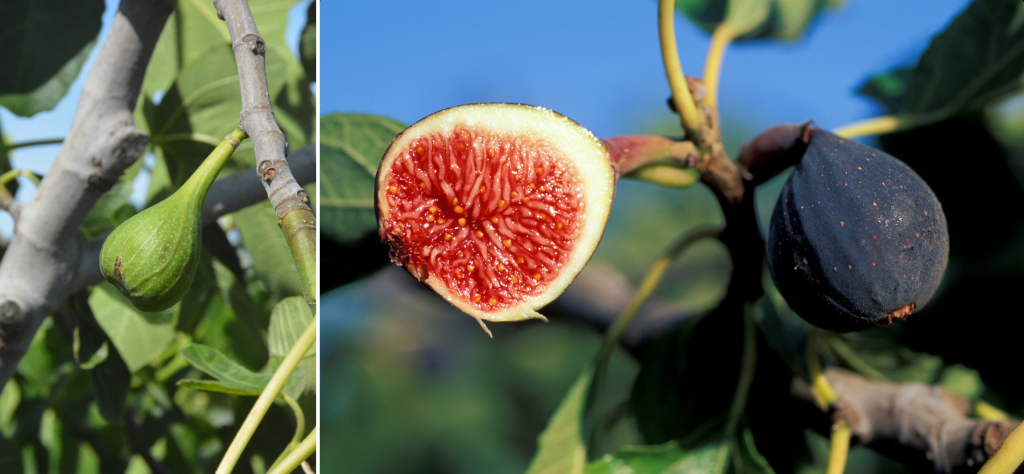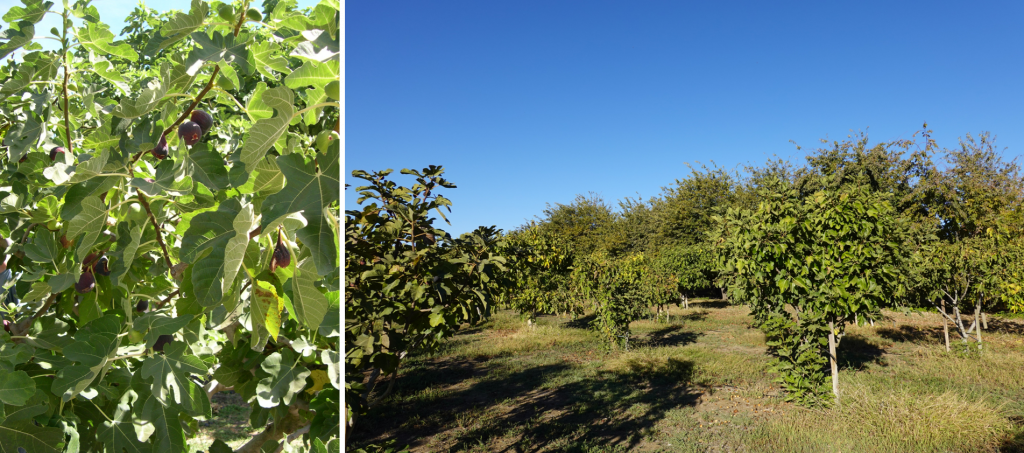Fig Collection
Alexander Sanchez, USDA-ARS National Clonal Germplasm Repository, One Shields Drive, University of California, Davis, California 95616
Gayle M. Volk, USDA-ARS National Laboratory for Genetic Resources Preservation, 1111 S. Mason St., Fort Collins, Colorado 80521
John E. Preece, USDA-ARS National Clonal Germplasm Repository, One Shields Drive, University of California, Davis, California 95616
Outline
1. Introduction
Figs belong to a temperate genus, Ficus, native from Southwest Asia to the Mediterranean. Ficus carica is the species that is most valued for its fruit. In 2017, there were 6,700 acres of figs produced in the U.S., primarily in California. The fresh market production had a value of $14,976,000 (USDA NASS, 2020).
Fig trees produce small hermaphroditic caprifigs and/or edible female figs. Tiny female wasps enter into caprifigs through the “eye” or ostiole. They lay eggs within the short styles of the female florets of the caprifig. The male florets are located in a mass just inside the ostiole. The eggs hatch and form larvae, which then mature to become wasps. The wasps mate within the caprifigs before they emerge. When the adult female wasps emerge from the caprifigs, they carry pollen from the male caprifig florets to either another caprifig or to a female fig. If the adult wasp enters a female fig, they pollinate the long styles within the fig but are unable to lay their eggs. When fertilized with pollen, female figs mature and can make hundreds of seeds.
Alternatively, “common” type figs develop parthenocarpic (derived without pollination) edible fruit without wasp pollination (Stover et al. 2007). Common figs are preferred by many because the wasp is not required and the non-pollinated figs have fewer microorganisms introduced because the wasp does not enter the fruit. Fig trees usually have a height of 3-10 meters. Fig tree cultivars are usually cultivated by cuttings, air-layering, or grafting. Seedlings from the trees are not identical to the parent.
Figure 1. Ficus male caprifig (left) and female edible fruit (right). Photo credit: Gayle Volk (left) and USDA Image Gallery (right).
2. Ficus (fig) collection
The U.S. National Plant Germplasm System fig collection has 230 unique accessions representing 23 taxa that are maintained as trees in the field. Fig cultivars in the collections are from rooted cuttings.
Figure 2. U.S. National Plant Germplasm System fig tree with fruit (left) and field fig collection (right). Photo credit: Gayle Volk.
Video 1. Dr. John Preece discusses the fig collection.
3. references
Flaishman MA, Rodov V, Stover E. 2008. The fig: botany, horticulture, and breeding. Horticultural Reviews 34:113-197.
Stover E, Aradhya M, Ferguson L, Crisosto CH. 2007. The fig: Overview of an ancient fruit. HortScience 42:1083-1087.
USDA National Agricultural Statistics Service (NASS). 2020. Accessed 4/20/2020. https://www.nass.usda.gov/Statistics_by_Subject/result.php?8FFEC53F-74D6-346C-8E0C-1A568CA4BA35§or=CROPS&group=FRUIT%20%26%20TREE%20NUTS&comm=FIGS
4. additional information
Curator: Alexander Sanchez, USDA-ARS National Clonal Germplasm Repository, One Shields Drive, University of California, Davis, CA 95616-8607, alexander.sanchez@usda.gov
5. Acknowledgments
Citation: Sanchez A, Volk GM, Preece JE. 2021. Fig collection. In: Volk GM, Preece JE (Ed.) Field tour of the USDA National Clonal Germplasm Repository for Tree Fruit, Nut Crops, and Grapes in Davis, California. Fort Collins, Colorado: Colorado State University. Date accessed. Available from: https://colostate.pressbooks.pub/davisrepositoryfieldtour/chapter/figs/
This training module was made possible in part by funding from USDA-ARS, Colorado State University, and the United States Agency for International Development (USAID).
Editors: Emma Balunek, Gayle Volk, Katheryn Chen
This project was funded in part by the National Academy of Sciences (NAS) and USAID, and any opinions, findings, conclusions, or recommendations expressed in such are those of the authors alone, and do not necessarily reflect the views of USAID or NAS. USDA is an equal opportunity provider and employer. Mention of trade names or commercial products in this article is solely for the purpose of providing specific information and does not imply recommendation or endorsement by the US Department of Agriculture.




